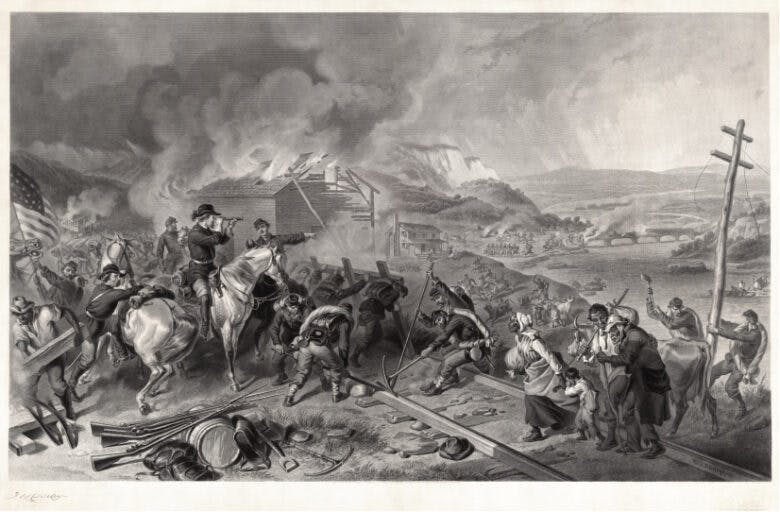Images of Total War: Sherman’s March to the Sea, 1865
Use this primary source imagery to analyze major events in history.
Suggested Sequencing
- Use this Primary Source alongside the J.B. Elliott, Scott’s Great Snake (Anaconda Plan), 1861 Primary Source and the William Tecumseh Sherman and Total War Narrative to illustrate the tactics the Union used to win the war.
Introduction
The campaign of total war, waged by Union forces under Ulysses S. Grant, was a military policy that broke from the norms of the time. Instead of having explicitly military targets, Union forces sought to destroy the Confederacy’s ability to maintain the war effort. In doing so, this policy also sought to subject the population of the South to extreme hardship to break their will and to destroy the material needed to continue in armed rebellion against the government. This policy was implemented particularly effectively by General William T. Sherman’s forces during his Atlanta campaign and those that followed the fall of Atlanta. These images capture some of the devastation wrought by the policy of total war upon Georgia and South Carolina, the birthplace of the rebellion.
Sourcing Questions
- What was the military objective of the Union’s “total war” strategy?
- Why were Georgia and South Carolina chosen as the targets of this policy?

Figure 1: Atlanta rail yard and roundhouse in ruins at end of the Civil War.

Figure 2: Sherman’s men destroying a railroad in Atlanta, Georgia.

Figure 3: Charleston, South Carolina: Broad Street, 1865.

Figure 4: Engraving of Sherman’s March to the Sea.
Comprehension Questions
- (Figure 1) What physical evidence do you see of the systematic destruction of the roundhouse and rail yard?
- (Figure 1) For what purpose do you think the locomotives were all clustered together by the Union troops?
- (Figure 2) In what two ways are the soldiers in this picture making the railroad inoperable?
- (Figure 2) What purposes would have been served by destroying a railroad?
- (Figure 3) How can you tell from this picture that few have lived or worked on Broad Street for some time?
- (Figure 3) What evidence is there that Broad Street was a prominent location before the war?
- (Figure 4) How does this engraving portray General Sherman and his army?
- (Figure 4) What purpose might the enslaved family illustrate in the artist’s intent in creating this image?
- (Figure 4) Compare the effectiveness of this engraving of total war with the preceding images. Which do you think is more affecting?
Historical Reasoning Questions
- In what ways do we see the practical reality of total war in these images?
- From these images, assess how effective the total war policy was in fulfilling its designers’ objectives.
Image 1: https://en.wikipedia.org/wiki/Reconstruction_era#/media/File:Atlanta_roundhouse_ruin3.jpg

